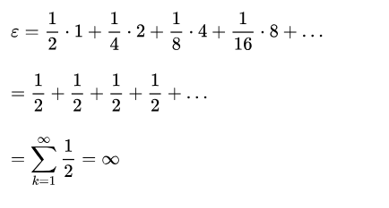As a complex science, Slots Design is to create a fantastic and attractive Slots, which is the eternal subject of every Slots designer or probability engineer. Honestly, no one can clearly point out what kind of design will be fun.
However, there is no doubt that all designers would agree: Generally, if we take RTP as one factor alone, the lower RTP is, the harder to attract players, otherwise, it inversed.
Does a high RTP really attract players?
If we design a Slot game with very high RTP, even far over 100, such as Slots with RTP = 10,000, will it really attract players to play like crazy all the time?
To answer the above question, it is necessary to understand what the St. Petersburg Paradox is.
According to an introduction from Wikipedia:
The St. Petersburg Paradox is a paradox in decision theory, proposed by Nicholas I Bernoulli. In 1738, Daniel Bernoulli used utility theory to answer this question, thus forming the theory of expected utility.
In the 1730s, Nicolas I Bernoulli, cousin of mathematician Daniel Bernoulli, in a letter to the French mathematician Pierre Remond de Montmort, posed a question: toss a coin, and if you toss a head for the first time, you earn $1. If you roll the reverse side the first time, you have to roll it again, and if the second roll is a head, you earn $2. If you throw the reverse for the second time, then you have to roll the third time, and if the third throw is a head, you will earn 2*2 yuan... And so on, the game may end with one roll, or it may be repeated endlessly.
The question is, how much are you willing to pay to participate in this game? The maximum amount you are willing to pay should be equal to the expected value of the game:

The expectation of this game is infinite, in other words, you are willing to pay unlimited money to participate in this game. However, you are more likely to earn only $1, or $2, or $4, etc., and it is impossible for you to earn unlimited money. So why are you willing to pay unlimited money to participate in the game?
Daniel Bernoulli solved this paradox in his paper that was published in 1738, challenging the expected value of money as a criterion for decision-making with the concept of utility, which included two main principles:
1. The law of diminishing marginal utility: the more wealth a person possesses, the better it will be, that is, the first derivative of the utility function is greater than zero. As wealth increases, the rate of satisfaction decreases, and the second derivative of the utility function is less than zero.
2. Rules for Maximizing Utility: Under the conditions of risk and uncertainty, the individual's decision-making code of conduct is to obtain the maximum expected utility value rather than the maximum expected amount value.
Going back to the game in the introduction, if the participation fee is 100,000 yuan, people would be short of willing to play. Applying the game concept in the paradox to the design of the Slots game, that is, designing a Slot that assumes that each reel costs 100,000 yuan, and this Slots has each reel 1/2 chance to win $1, 1/4 chance to win $2, 1/8 chance to win $4... 1/2K chance of winning 2K-1 yuan
K = 20 million, not to infinity. That calculated expected value per spin is to win $10 million, which happens to be the Slots with RTP = 10,000 mentioned at the beginning of the article.
Would you be willing to spend $100,000 per spin?
The answer is obvious. Therefore, we have a conclusion that even a Slot with an RTP of 10,000 also cannot attract players.
Introduction answer from Wikipedia, namely:
The code of conduct for individual decision-making is to obtain the maximum expected utility value, not the maximum expected amount value.
To explain it in gambling industry terms, players are pursuing the feeling that there will be a chance to win with a small broad, which is usually the experience brought by the content after triggering the free game, rather than the pursuit of a betting game with the largest RTP.
To continue this issue, we should also talk about Volatility. Actually, Slots that attract players must have a proper Volatility model, neither high nor low.
What exactly is the appropriate Volatility model? As mentioned at the beginning of the article, has not yet been clearly pointed out. There is also no fixed best solution to this problem, the preferences of players in different markets and different platforms are different, even if the same market and the same platform, the tastes of players may gradually change over time. In consequence, this is, truthfully, the eternal problem of every Slots designer or probability engineer.
Foxuc has focused on the development of board games at home and abroad for many years, and has successfully launched a large number of popular board games. According to your needs, we can quickly develop different types of mature board game products to help you occupy the board game market. If you have relevant intentions, Please contact us. We are looking forward to cooperating with you.
Mrs Aileen
Telegram:@qpkf1688
WhatsApp:+6289514312309
WeChat:15099945310
E-mail:Aileen@foxuc.cn

